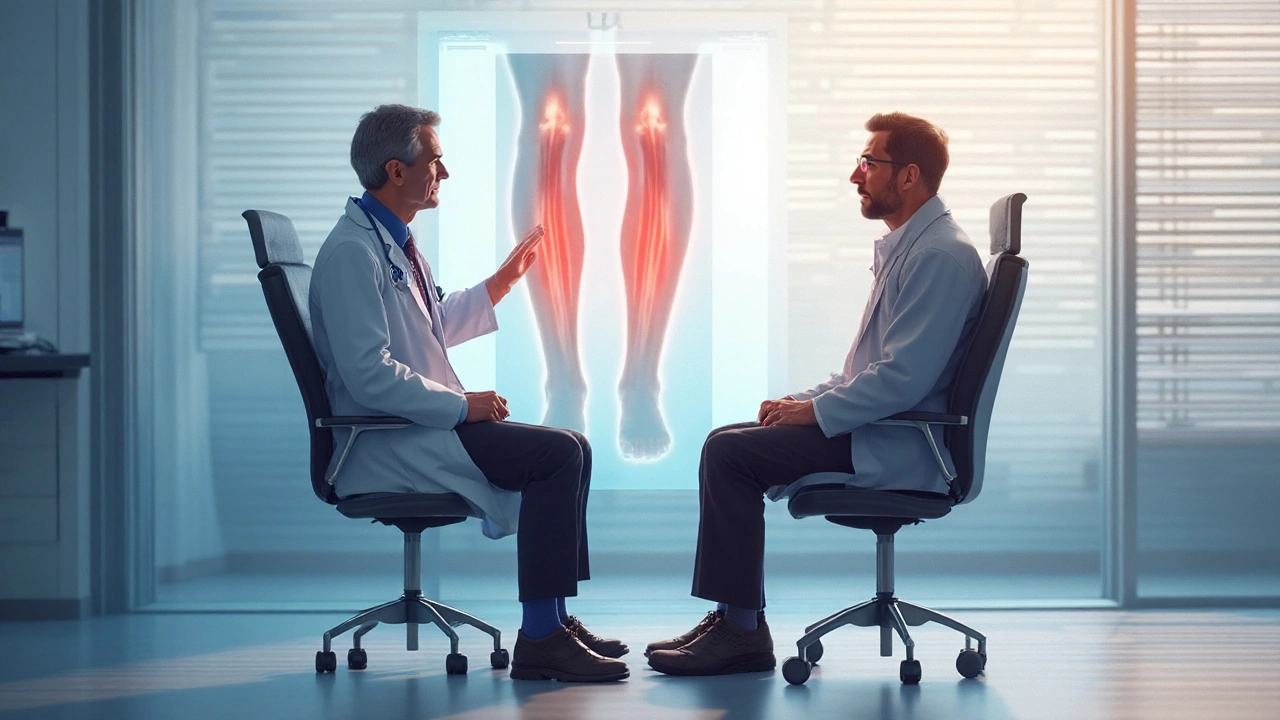Embolism is a vascular event where a clot, fat, air or other material travels through the bloodstream and blocks a distal vessel. When the blockage occurs in the leg veins, it can set off a cascade that culminates in Chronic Venous Insufficiency a long‑term condition marked by faulty venous valves, venous hypertension and persistent edema. Understanding how these two conditions intertwine helps clinicians spot early warning signs, intervene promptly, and reduce the lifelong burden of leg swelling, skin changes and ulceration.
Why Embolism Matters for Venous Health
Most people associate emboli with heart attacks or strokes, but a venous embolism - often the result of a deep‑vein thrombosis (DVT) that dislodges - can also damage the veins that return blood to the heart. When a clot lodges in a superficial or deep vein, it creates an acute pressure spike. The sudden rise in Venous Hypertension elevated pressure within the venous system forces the vein walls to stretch, stretches the leaf‑like venous valves, and may cause them to become incompetent.
Key Players in the Embolism‑CVI Axis
- Deep Vein Thrombosis (DVT) formation of a blood clot in the deep veins, usually of the thigh or calf
- Venous Valve Incompetence failure of venous valves to close properly, allowing backflow of blood
- Compression Therapy use of graded elastic stockings or wraps to counteract venous pressure
- Duplex Ultrasound a non‑invasive imaging technique that visualises blood flow and valve function
- Anticoagulation medication regimen that prevents clot propagation and new clot formation
The Pathophysiological Bridge
When a thrombus dislodges, it can travel downstream and become a pulmonary embolus or, more subtly, lodge in peripheral veins. Even a partially dissolved clot leaves behind fibrotic strands that adhere to the vein wall. This scarring narrows the lumen and disrupts the normal shear stress that keeps venous valves healthy. Over weeks to months, the damaged valve leaflets no longer co‑apt, leading to reflux. The reflux forces blood to pool in the calf and ankle, raising interstitial pressure and triggering the classic skin changes of CVI - hemosiderin staining, lipodermatosclerosis and, in severe cases, ulceration.
Clinical Red Flags Linking the Two Conditions
Patients who present with a recent DVT or unexplained leg pain should be screened for early signs of CVI. Look for:
- Persistent swelling beyond the acute phase (more than 2 weeks)
- Visible varicose veins that were absent before the embolic event
- Skin discoloration or mild itching around the ankle
- Reduced ankle‑brachial index (suggesting compromised outflow)
These clues hint that the venous system is not recovering, and targeted therapy can halt progression.
Diagnostic Toolbox
Accurate diagnosis relies on a combination of clinical scoring and imaging.
- History and physical exam - use the CEAP classification (Clinical, Etiology, Anatomy, Pathophysiology) to stage CVI.
- Duplex Ultrasound - maps clot location, measures vein diameter, and quantifies reflux duration (≥0.5seconds indicates pathology).
- Blood work - D‑dimer levels can confirm ongoing thrombosis; inflammatory markers (CRP, ESR) help differentiate cellulitis from venous dermatitis.
- When ultrasound is inconclusive, consider MR venography or CT venography for detailed anatomy.

Management Strategies: From Clot to Valve
Treating the embolic source and protecting the veins go hand‑in‑hand.
- Anticoagulation - Initiate low‑molecular‑weight heparin or direct oral anticoagulants within 24hours of DVT diagnosis. Continue for at least 3months, extending to 6-12months if valve damage is evident.
- Compression Therapy - Prescription‑grade elastic stockings (30‑40mmHg at the ankle) worn day and night for the first 6weeks markedly reduce edema and improve valve competence.
- Early Mobilisation - Simple calf‑pump exercises stimulate venous return and limit stasis.
- Endovenous Ablation - For isolated incompetent saphenous veins, laser or radio‑frequency ablation can eliminate reflux sources, sparing the deep system from overload.
- Skin Care - Moisturise, protect with barrier creams, and treat super‑imposed infection promptly to prevent ulcer formation.
Comparison: Embolism vs. Deep‑Vein Thrombosis
| Feature | Embolism | DVT |
|---|---|---|
| Origin | Clot or material travels from elsewhere | Clot forms in situ within deep veins |
| Typical Location | Pulmonary arteries, cerebral vasculature, peripheral veins | Femoral, popliteal, iliac veins |
| Symptoms | Sudden dyspnea, chest pain, leg pain if peripheral | Gradual swelling, pain, warmth over calf |
| Primary Risk Factors | Recent surgery, atrial fibrillation, prolonged immobility | Inherited thrombophilia, obesity, hormonal therapy |
| First‑Line Treatment | Anticoagulation + thrombolysis in severe cases | Anticoagulation, compression, early ambulation |
| Long‑Term Impact on Veins | Can cause valve damage → chronic venous insufficiency | May lead to post‑thrombotic syndrome, also a CVI cause |
Prevention: Stopping the Cycle Before It Starts
Because embolic events and CVI share many lifestyle and medical risk factors, a combined prevention plan works best.
- Weight Management - Maintaining a BMI<25kg/m² reduces venous pressure and clot propensity.
- Smoking Cessation - Nicotine accelerates platelet aggregation and impairs endothelial function.
- Regular Activity - Walking 30minutes daily activates calf‑muscle pump, averting stasis.
- Hydration - Adequate fluid intake keeps blood viscosity low.
- Medical Surveillance - For patients with known hypercoagulable states, periodic D‑dimer testing and ultrasound screening can catch subclinical clot formation.
Related Concepts Worth Exploring
While this article focuses on the embolism‑CVI link, several adjacent topics deepen the picture:
- Phlebology - the specialty that studies venous disorders; a good referral point for complex cases.
- Post‑Thrombotic Syndrome - a condition overlapping with CVI, characterised by chronic pain and skin changes after DVT.
- Venous Stasis Dermatitis - inflammation driven by fluid accumulation, often misdiagnosed as cellulitis.
- Endovascular Interventions - emerging minimally invasive techniques (e.g., stenting of iliac veins) that restore flow and reduce reflux.
What to Do Next
If you’ve experienced a recent clot, schedule a duplex exam within two weeks to assess valve function. Ask your clinician about graduated compression stockings and whether a short‑term anticoagulation plan fits your health profile. For those without a clot history but with leg heaviness or varicose veins, an early visit to a phlebologist can uncover hidden reflux before it turns into chronic insufficiency.

Frequently Asked Questions
Can an embolism cause varicose veins?
Yes. When an embolus lodges in a superficial or deep vein, it raises venous pressure and can damage the valves. Damaged valves allow blood to flow backward, which over time expands the vein walls and creates varicose veins.
How long after a DVT should I wear compression stockings?
Guidelines suggest at least 6weeks of daily wear, extending to 6‑12months if reflux persists. The stockings should provide 30‑40mmHg pressure at the ankle and be graduated up the calf.
Is anticoagulation enough to prevent chronic venous insufficiency?
Anticoagulation stops clot growth but does not repair valve damage already incurred. Combining anticoagulation with compression therapy and early mobilisation gives the best chance of preserving valve function.
What are the warning signs of post‑thrombotic syndrome?
Symptoms include persistent leg swelling, heaviness, skin discoloration, aching pain, and, in severe cases, ulcer formation along the medial ankle.
Can lifestyle changes reverse early chronic venous insufficiency?
Early disease is often manageable. Weight loss, regular walking, smoking cessation, and consistent use of compression stockings can improve venous return and halt progression, though the structural changes in the valves are usually permanent.

Scott Mcdonald
Man, I had a DVT last year after that cross-country flight. Didn’t think twice until my ankle looked like a purple balloon. Compression socks saved my life-wore ‘em 24/7 for a month. Still wear ‘em on flights now. Don’t be like me and ignore the swelling.
Victoria Bronfman
OMG I’m so glad this exists 😭 I literally just Googled 'why does my leg feel like it’s full of jelly' and found this. The CEAP classification? Chef’s kiss. 🫶 I’m telling my vascular doc I’m now a CVI connoisseur. Also, #DVTawareness 🌟
Gregg Deboben
This is why America needs to stop letting people sit on planes for 12 hours like it’s a spa day. We’re getting soft. Back in my day, we walked 10 miles to the airport and came back with calluses, not clots. This ‘compression therapy’ nonsense? Just move your damn legs. Also, why is everyone so obsessed with ‘valve incompetence’? It’s not a yoga pose.
Christopher John Schell
You got this! 💪 Seriously, if you’ve had a DVT, don’t beat yourself up-this is a medical hiccup, not a personal failure. Start small: calf pumps while watching Netflix, drink water like it’s your job, and those compression socks? They’re your new besties. One day at a time, friend. You’re stronger than this clot!
Felix Alarcón
Hey, just wanted to say this post made me think about my grandma in Mexico-she had swollen legs for years, but no one ever called it CVI. They just said 'she's old.' But now I see it might’ve been valve damage from an old clot she never knew about. We need to talk about this in more languages. Also, typo: 'veins' link is broken 😅
Lori Rivera
While the pathophysiology described is clinically accurate, the omission of venous reflux quantification thresholds in the diagnostic section is notable. A reflux duration exceeding 0.5 seconds is indeed pathological, yet inter-observer variability in duplex measurements remains a significant confounder in clinical practice.
Leif Totusek
Thank you for presenting this information with such clarity and precision. The integration of clinical scoring systems with imaging modalities provides a robust framework for early intervention. I shall reference this in my upcoming lecture on vascular pathology.
KAVYA VIJAYAN
Let me break this down like I’m explaining it to my cousin who’s a truck driver. So, imagine your veins are like one-way streets with tiny doors (valves) that only open one way. When a clot blocks the road, the pressure builds up like traffic behind a crash. Those doors get stretched out, stop closing right, and now blood flows backward-like cars rolling uphill. That’s why your ankles swell like balloons. And no, it’s not just ‘water retention’-it’s structural damage. And guess what? Once those valves are wrecked, they don’t heal. You can’t un-stretch a rubber band. That’s why anticoagulants aren’t just ‘preventing clots’-they’re protecting your valves from getting wrecked in the first place. And compression socks? They’re not fashion. They’re your external valve system. You’re basically wearing a hydraulic brace. If you skip them, you’re just delaying the ulcers. And yes, I’ve seen it. My uncle had a leg that looked like a dried-up prune. He didn’t listen. Now he’s on disability. Don’t be him.
Jarid Drake
Biggest takeaway for me: early mobilization. I used to think bed rest was the answer after a clot. Nope. Got up, walked around the house, did ankle circles. Made all the difference. Also, those socks are weird but worth it.
Tariq Riaz
Interesting how this post frames embolism as a direct cause of CVI, but ignores the fact that most CVI cases are primary (congenital valve weakness), not post-thrombotic. The data shows only ~20-30% of CVI stems from DVT. This overattribution is misleading. Also, why is MR venography listed as a ‘last resort’? It’s superior to CT in soft tissue contrast and avoids radiation. This is sloppy clinical framing.
Roderick MacDonald
Listen, I know this sounds intense, but hear me out-this isn’t just about legs. It’s about your freedom. If you let CVI take root, you’re not just dealing with swelling-you’re losing your ability to hike, play with your kids, even stand at the grill without pain. But here’s the good news: you can stop it. Anticoagulants? Check. Socks? Check. Walking? Check. Skin care? Double check. You’re not broken-you’re just in the middle of a turning point. And you’ve got the power to change the outcome. One step. One sock. One day. You got this. 🌞
Chantel Totten
Thank you for sharing this. I’ve seen friends struggle with this silently. The skin changes are so easily dismissed as ‘just aging’ or ‘allergies.’ This helps give language to something that’s often invisible.